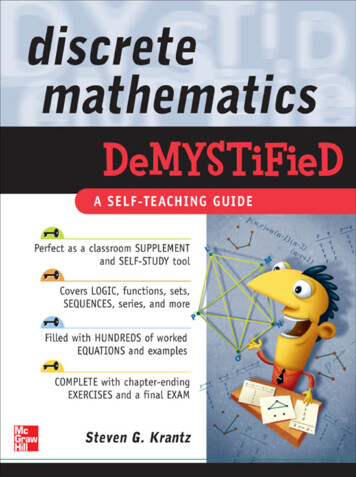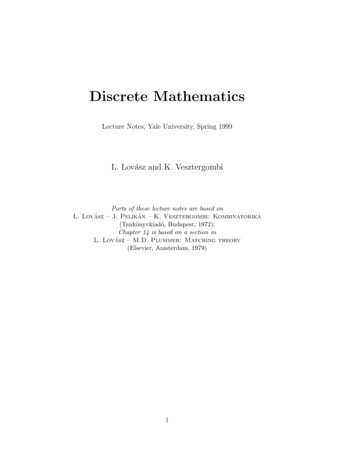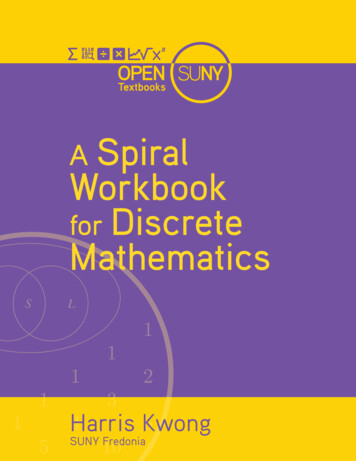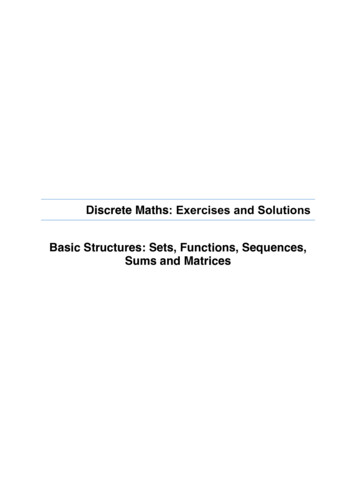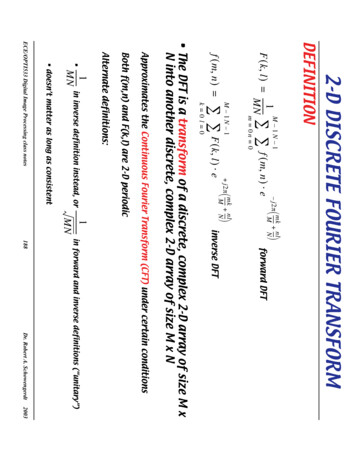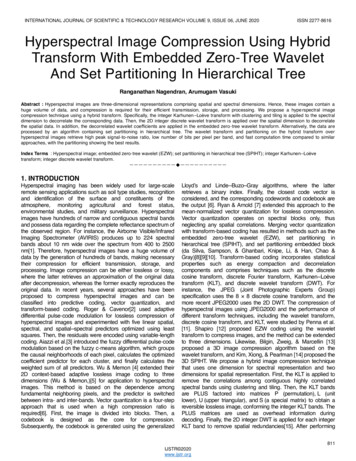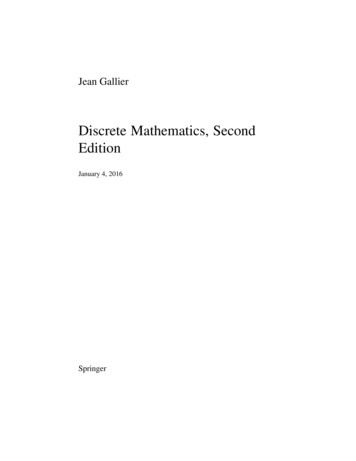
Transcription
Jean GallierDiscrete Mathematics, SecondEditionJanuary 4, 2016Springer
Chapter 6An Introduction to Discrete Probability6.1 Sample Space, Outcomes, Events, ProbabilityRoughly speaking, probability theory deals with experiments whose outcome arenot predictable with certainty. We often call such experiments random experiments.They are subject to chance. Using a mathematical theory of probability, we may beable to calculate the likelihood of some event.In the introduction to his classical book [1] (first published in 1888), JosephBertrand (1822–1900) writes (translated from French to English):“How dare we talk about the laws of chance (in French: le hasard)? Isn’t chancethe antithesis of any law? In rejecting this definition, I will not propose anyalternative. On a vaguely defined subject, one can reason with authority. .”Of course, Bertrand’s words are supposed to provoke the reader. But it does seemparadoxical that anyone could claim to have a precise theory about chance! It is notmy intention to engage in a philosophical discussion about the nature of chance.Instead, I will try to explain how it is possible to build some mathematical tools thatcan be used to reason rigorously about phenomema that are subject to chance. Thesetools belong to probability theory. These days, many fields in computer sciencesuch as machine learning, cryptography, computational linguistics, computer vision,robotics, and of course algorithms, rely a lot on probability theory. These fields arealso a great source of new problems that stimulate the discovery of new methodsand new theories in probability theory.Although this is an oversimplification that ignores many important contributors,one might say that the development of probability theory has gone through four eraswhose key figures are: Pierre de Fermat and Blaise Pascal, Pierre–Simon Laplace,and Andrey Kolmogorov. Of course, Gauss should be added to the list; he mademajor contributions to nearly every area of mathematics and physics during his lifetime. To be fair, Jacob Bernoulli, Abraham de Moivre, Pafnuty Chebyshev, Aleksandr Lyapunov, Andrei Markov, Emile Borel, and Paul Lévy should also be addedto the list.367
3686 An Introduction to Discrete ProbabilityFig. 6.1 Pierre de Fermat (1601–1665) (left), Blaise Pascal (1623–1662) (middle left), Pierre–Simon Laplace (1749–1827) (middle right), Andrey Nikolaevich Kolmogorov (1903–1987) (right)Before Kolmogorov, probability theory was a subject that still lacked precise definitions. In1933, Kolmogorov provided a precise axiomatic approach to probabilitytheory which made it into a rigorous branch of mathematics; with even more applications than before!The first basic assumption of probability theory is that even if the outcome of anexperiment is not known in advance, the set of all possible outcomes of an experiment is known. This set is called the sample space or probability space. Let us beginwith a few examples.Example 6.1. If the experiment consists of flipping a coin twice, then the samplespace consists of all four stringsΩ {HH, HT, TH, TT},where H stands for heads and T stands for tails.If the experiment consists in flipping a coin five times, then the sample spaceΩ is the set of all strings of length five over the alphabet {H, T}, a set of 25 32strings,Ω {HHHHH, THHHH, HTHHH, TTHHH, . . . , TTTTT}.Example 6.2. If the experiment consists in rolling a pair of dice, then the samplespace Ω consists of the 36 pairs in the setΩ D DwithD {1, 2, 3, 4, 5, 6},where the integer i D corresponds to the number (indicated by dots) on the face ofthe dice facing up, as shown in Figure 6.2. Here we assume that one dice is rolledfirst and then another dice is rolled second.Example 6.3. In the game of bridge, the deck has 52 cards and each player receivesa hand of 13 cards. Let Ω be the sample space of all possible hands. This time it isnot possible to enumerate the sample space explicitly. Indeed, there are
6.1 Sample Space, Outcomes, Events, Probability369Fig. 6.2 Two dice 52 · 51 · 50 · · · 405252! 635, 013, 559, 600 1313! · 39!13 · 12 · · · · 2 · 1different hands, a huge number.Each member of a sample space is called an outcome or an elementary event.Typically, we are interested in experiments consisting of a set of outcomes. Forexample, in Example 6.1 where we flip a coin five times, the event that exactly oneof the coins shows heads isA {HTTTT, THTTT, TTHTT, TTTHT, TTTTH}.The event A consists of five outcomes. In Example 6.3, the event that we get “doubles” when we roll two dice, namely that each dice shows the same value is,B {(1, 1), (2, 2), (3, 3), (4, 4), (5, 5), (6, 6)},an event consisting of 6 outcomes.The second basic assumption of probability theory is that every outcome ω ofa sample space Ω is assigned some probability Pr(ω). Intuitively, Pr(ω) is theprobabilty that the outcome ω may occur. It is convenient to normalize probabilites,so we require that0 Pr(ω) 1.If Ω is finite, we also require that Pr(ω) 1.ω ΩThe function Pr is often called a probability distribution on Ω . Indeed, it distributesthe probability of 1 among the outomes ω.In many cases, we assume that the probably distribution is uniform, which meansthat every outcome has the same probability.For example, if we assume that our coins are “fair,” then when we flip a coin fivetimes, since each outcome in Ω is equally likely, the probability of each outcomeω Ω is1Pr(ω) .32
3706 An Introduction to Discrete ProbabilityIf we assume that our dice are “fair,” namely that each of the six possibilities for aparticular dice has probability 1/6 , then each of the 36 rolls ω Ω has probabilityPr(ω) 1.36We can also consider “loaded dice” in which there is a different distribution ofprobabilities. For example, letPr1 (1) Pr1 (6) 141Pr1 (2) Pr1 (3) Pr1 (4) Pr1 (5) .8These probabilities add up to 1, so Pr1 is a probability distribution on D. We canassign probabilities to the elements of Ω D D by the rulePr11 (d, d 0 ) Pr1 (d)Pr1 (d 0 ).We can easily check that Pr11 (ω) 1,ω Ωso Pr11 is indeed a probability distribution on Ω . For example, we getPr11 (6, 3) Pr1 (6)Pr1 (3) 11 1· .4 8 32Let us summarize all this with the following definition.Definition 6.1. A finite discrete probability space (or finite discrete sample space)is a finite set Ω of outcomes or elementary events ω Ω , together with a functionPr : Ω R, called probability measure (or probability distribution) satisfying thefollowing properties:0 Pr(ω) 1 Pr(ω) 1.for all ω Ω .ω ΩAn event is any subset A of Ω . The probability of an event A is defined asPr(A) Pr(ω).ω ADefinition 6.1 immediately implies thatPr(0)/ 0Pr(Ω ) 1.
6.1 Sample Space, Outcomes, Events, Probability371For another example, if we consider the eventA {HTTTT, THTTT, TTHTT, TTTHT, TTTTH}that in flipping a coin five times, heads turns up exactly once, the probability of thisevent is5Pr(A) .32If we use the probability distribution Pr on the sample space Ω of pairs of dice, theprobability of the event of having doublesB {(1, 1), (2, 2), (3, 3), (4, 4), (5, 5), (6, 6)},is11 .36 6However, using the probability distribution Pr11 , we obtainPr(B) 6 ·Pr11 (B) 11111131 .16 64 64 64 64 16 16 16Loading the dice makes the event “having doubles” more probable.It should be noted that a definition slightly more general than Definition 6.1 isneeded if we want to allow Ω to be infinite. In this case, the following definition isused.Definition 6.2. A discrete probability space (or discrete sample space) is a triple(Ω , F , Pr) consisting of:1. A nonempty countably infinite set Ω of outcomes or elementary events.2. The set F of all subsets of Ω , called the set of events.3. A function Pr : F R, called probability measure (or probability distribution)satisfying the following properties:a. (positivity)0 Pr(A) 1for all A F .b. (normalization)Pr(Ω ) 1.c. (additivity and continuity)For any sequence of pairwise disjoint events E1 , E2 , . . . , Ei , . . . in F (whichmeans that Ei E j 0/ for all i 6 j), we have!Pr [i 1 Ei Pr(Ei ).i 1The main thing to observe is that Pr is now defined directly on events, sinceevents may be infinite. The third axiom of a probability measure implies that
3726 An Introduction to Discrete ProbabilityPr(0)/ 0.The notion of a discrete probability space is sufficient to deal with most problemsthat a computer scientist or an engineer will ever encounter. However, there arecertain problems for which it is necessary to assume that the family F of eventsis a proper subset of the power set of Ω . In this case, F is called the family ofmeasurable events, and F has certain closure properties that make it a σ -algebra(also called a σ -field). Some problems even require Ω to be uncountably infinite. Inthis case, we drop the word discrete from discrete probability space.Remark: A σ -algebra is a nonempty family F of subsets of Ω satisfying the following properties:1. 0/ F .2. For every subset A Ω , if A F then A F .S3. For every countable family (Ai )i 1 of subsets Ai F , we have i 1 Ai F .Note that every σ -algebra is a Boolean algebra (see Section 7.11, Definition 7.14),but the closure property (3) is very strong and adds spice to the story.In this chapter, we deal mostly with finite discrete probability spaces, and occasionally with discrete probability spaces with a countably infinite sample space. Inthis latter case, we always assume that F 2Ω , and for notational simplicity weomit F (that is, we write (Ω , Pr) instead of (Ω , F , Pr)).Because events are subsets of the sample space Ω , they can be combined usingthe set operations, union, intersection, and complementation. If the sample spaceΩ is finite, the definition for the probability Pr(A) of an event A Ω given inDefinition 6.1 shows that if A, B are two disjoint events (this means that A B 0),/thenPr(A B) Pr(A) Pr(B).More generally, if A1 , . . . , An are any pairwise disjoint events, thenPr(A1 · · · An ) Pr(A1 ) · · · Pr(An ).It is natural to ask whether the probabilities Pr(A B), Pr(A B) and Pr(A) canbe expressed in terms of Pr(A) and Pr(B), for any two events A, B Ω . In the firstand the third case, we have the following simple answer.Proposition 6.1. Given any (finite) discrete probability space (Ω , Pr), for any twoevents A, B Ω , we havePr(A B) Pr(A) Pr(B) Pr(A B)Pr(A) 1 Pr(A).Furthermore, if A B, then Pr(A) Pr(B).Proof . Observe that we can write A B as the following union of pairwise disjointsubsets:
6.1 Sample Space, Outcomes, Events, Probability373A B (A B) (A B) (B A).Then, using the observation made just before Proposition 6.1, since we have the disjoint unions A (A B) (A B) and B (A B) (B A), using the disjointnessof the various subsets, we havePr(A B) Pr(A B) Pr(A B) Pr(B A)Pr(A) Pr(A B) Pr(A B)Pr(B) Pr(A B) Pr(B A),and from these we obtainPr(A B) Pr(A) Pr(B) Pr(A B).The equation Pr(A) 1 Pr(A) follows from the fact that A A 0/ and A A Ω ,so1 Pr(Ω ) Pr(A) Pr(A).If A B, then A B A, so B (A B) (B A) A (B A), and since A andB A are disjoint, we getPr(B) Pr(A) Pr(B A).Since probabilities are nonegative, the above implies that Pr(A) Pr(B). tuRemark: Proposition 6.1 still holds when Ω is infinite as a consequence of axioms(a)–(c) of a probability measure. Also, the equationPr(A B) Pr(A) Pr(B) Pr(A B)can be generalized to any sequence of n events. In fact, we already showed this asthe Principle of Inclusion–Exclusion, Version 2 (Theorem 5.2).The following proposition expresses a certain form of continuity of the functionPr.Proposition 6.2. Given any probability space (Ω , F , Pr) (discrete or not), for anysequence of events (Ai )i 1 , if Ai Ai 1 for all i 1, then Pr [ Ai lim Pr(An ).n7 i 1Proof . The trick is to expresswe have [i 1S i 1 Aias a union of pairwise disjoint events. Indeed,Ai A1 (A2 A1 ) (A3 A2 ) · · · (Ai 1 Ai ) · · · ,so by property (c) of a probability measure
3746 An Introduction to Discrete Probability Pr [ Aii 1 [ Pr A1 (Ai 1 Ai )i 1 Pr(A1 ) Pr(Ai 1 Ai )i 1n 1 Pr(A1 ) limn7 Pr(Ai 1 Ai )i 1 lim Pr(An ),n7 as claimed.We leave it as an exercise to prove that if Ai 1 Ai for all i 1, then \PrAi lim Pr(An ).i 1n7 In general, the probability Pr(A B) of the event A B cannot be expressed in asimple way in terms of Pr(A) and Pr(B). However, in many cases we observe thatPr(A B) Pr(A)Pr(B). If this holds, we say that A and B are independent.Definition 6.3. Given a discrete probability space (Ω , Pr), two events A and B areindependent ifPr(A B) Pr(A)Pr(B).Two events are dependent if they are not independent.For example, in the sample space of 5 coin flips, we have the eventsA {HHw w {H, T}3 } {HTw w {H, T}3 },the event in which the first flip is H, andB {HHw w {H, T}3 } {THw w {H,T}3 },the event in which the second flip is H. Since A and B contain 16 outcomes, we havePr(A) Pr(B) 16 1 .32 2The intersection of A and B isA B {HHw w {H, T}3 },the event in which the first two flips are H, and since A B contains 8 outcomes, wehave81Pr(A B) .32 4Since
6.1 Sample Space, Outcomes, Events, Probability375Pr(A B) 14and1 1 1· ,2 2 4we see that A and B are independent events. On the other hand, if we consider theeventsA {TTTTT, HHTTT}Pr(A)Pr(B) andB {TTTTT, HTTTT},we havePr(A) Pr(B) 21 ,32 16and sinceA B {TTTTT},we havePr(A B) It follows thatPr(A)Pr(B) 1.321 11· ,16 16 256butPr(A B) 1,32so A and B are not independent.Example 6.4. We close this section with a classical problem in probability known asthe birthday problem. Consider n 365 individuals and assume for simplicity thatnobody was born on February 29. In this problem, the sample space is the set ofall 365n possible choices of birthdays for n individuals, and let us assume that theyare all equally likely. This is equivalent to assuming that each of the 365 days ofthe year is an equally likely birthday for each individual, and that the assignmentsof birthdays to distinct people are independent. Note that this does not take twinsinto account! What is the probability that two (or more) individuals have the samebirthday?To solve this problem, it is easier to compute the probability that no two individuals have the same birthday. We can choose n distinct birthdays in 365n ways, andthese can be assigned to n people in n! ways, so there are 365n! 365 · 364 · · · (365 n 1)nconfigurations where no two people have the same birthday. There are 365n possiblechoices of birthdays, so the probabilty that no two people have the same birthday is
3766 An Introduction to Discrete Probabilityq 1365 · 364 · · · (365 n 1)2n 1 1 1 ···1 ,365n365365365and thus, the probability that two people have the same birthday is 2n 111 ··· 1 .p 1 q 1 1 365365365In the proof of Proposition 5.15, we showed that x ex 1 for all x R, so 1 x e xfor all x R, and we can bound q as follows: n 1 iq 1 365i 1n 1q e i/365i 1n 1 e i 1e n(n 1)2·365i365.If we want the probability q that no two people have the same birthday to be at most1/2, it suffices to requiren(n 1)1e 2·365 ,2that is, n(n 1)/(2 · 365) ln(1/2), which can be written asn(n 1) 2 · 365 ln 2.The roots of the quadratic equationn2 n 2 · 365 ln 2 0are 1 1 8 · 365 ln 2m ,2and we find that the positive root is approximately m 23. In fact, we find that ifn 23, then p 50.7%. If n 30, we calculate that p 71%.What if we want at least three people to share the same birthday? Then n 88does it, but this is harder to prove! See Ross [12], Section 3.4.Next, we define what is perhaps the most important concept in probability: thatof a random variable.
6.2 Random Variables and their Distributions3776.2 Random Variables and their DistributionsIn many situations, given some probability space (Ω , Pr), we are more interestedin the behavior of functions X : Ω R defined on the sample space Ω than in theprobability space itself. Such functions are traditionally called random variables, asomewhat unfortunate terminology since these are functions. Now, given any realnumber a, the inverse image of aX 1 (a) {ω Ω X(ω) a},is a subset of Ω , thus an event, so we may consider the probability Pr(X 1 (a)),denoted (somewhat improperly) byPr(X a).This function of a is of great interest, and in many cases it is the function that wewish to study. Let us give a few examples.Example 6.5. Consider the sample space of 5 coin flips, with the uniform probabilitymeasure (every outcome has the same probability 1/32). Then, the number of timesX(ω) that H appears in the sequence ω is a random variable. We determine that13210Pr(X 3) 32Pr(X 0) 5325Pr(X 4) 32Pr(X 1) 10321Pr(X 5) .32Pr(X 2) The function defined Y such that Y (ω) 1 iff H appears in ω, and Y (ω) 0otherwise, is a random variable. We have13231Pr(Y 1) .32Pr(Y 0) Example 6.6. Let Ω D D be the sample space of dice rolls, with the uniformprobability measure Pr (every outcome has the same probability 1/36). The sumS(ω) of the numbers on the two dice is a random variable. For example,S(2, 5) 7.The value of S is any integer between 2 and 12, and if we compute Pr(S s) fors 2, . . . , 12, we find the following table:s2 3 4 5 6 7 8 9 10 11 121 2 3 4 5 6 5 4 3 2 1Pr(S s) 3636 36 36 36 36 36 36 36 36 36Here is a “real” example from computer science.
3786 An Introduction to Discrete ProbabilityExample 6.7. Our goal is to sort of a sequence S (x1 , . . . , xn ) of n distinct realnumbers in increasing order. We use a recursive method known as quicksort whichproceeds as follows:1. If S has one or zero elements return S.2. Pick some element x xi in S called the pivot.3. Reorder S in such a way that for every number x j 6 x in S, if x j x, then x j ismoved to a list S1 , else if x j x then x j is moved to a list S2 .4. Apply this algorithm recursively to the list of elements in S1 and to the list ofelements in S2 .5. Return the sorted list S1 , x, S2 .Let us run the algorithm on the input listS (1, 5, 9, 2, 3, 8, 7, 14, 12, 10).We can represent the choice of pivots and the steps of the algorithm by an orderedbinary tree as shown in Figure 6.3. Except for the root node, every node corresponds(1, 5, 9, 2, 3, 8, 7, 14, 12, 10)1/10(1, 2)3(5, 9, 8, 7, 14, 12, 10)1/2()11/7(2)(5, 7)8(5)7(9, 14, 12, 10)1/41/2()(9) 10 (14, 12)1/2() 12 (14)Fig. 6.3 A tree representation of a run of quicksortto the choice of a pivot, say x. The list S1 is shown as a label on the left of node x,and the list S2 is shown as a label on the right of node x. A leaf node is a node suchthat S1 1 and S2 1. If S1 2, then x has a left child, and if S2 2, then xhas a right child. Let us call such a tree a computation tree. Observe that except forminor cosmetic differences, it is a binary search tree. The sorted list can be retrievedby a suitable traversal of the computation tree, and is
6.2 Random Variables and their Distributions379(1, 2, 3, 5, 7, 8, 9, 10, 12, 14).If you run this algorithm on a few more examples, you will realize that the choiceof pivots greatly influences how many comparisons are needed. If the pivot is chosenat each step so that the size of the lists S1 and S2 is roughly the same, then the numberof comparisons is small compared to n, in fact O(n ln n). On the other hand, with apoor choice of pivot, the number of comparisons can be as bad as n(n 1)/2.In order to have a good “average performance,” one can randomize this algorithmby assuming that each pivot is chosen at random. What this means is that wheneverit is necessary to pick a pivot from some list Y , some procedure is called and thisprocedure returns some element chosen at random from Y . How exactly this done isan interesting topic in itself but we will not go into this. Let us just say that the pivotcan be produced by a random number generator, or by spinning a wheel containingthe numbers in Y on it, or by rolling a dice with as many faces as the numbers in Y .What we do assume is that the probability distribution that a number is chosen froma list Y is uniform, and that successive choices of pivots are independent. How dowe model this as a probability space?Here is a way to do it. Use the computation trees defined above! Simply addto every edge the probability that one of the element of the corresponding list, sayY , was chosen uniformly, namely 1/ Y . So, given an input list S of length n, thesample space Ω is the set of all computation trees T with root label S. We assigna probability to the trees T in Ω as follows: If n 0, 1, then there is a single treeand its probability is 1. If n 2, for every leaf of T , multiply the probabilities alongthe path from the root to that leaf and then add up the probabilities assigned tothese leaves. This is Pr(T ). We leave it as an exercise to prove that the sum of theprobabilities of all the trees in Ω is equal to 1.A random variable of great interest on (Ω , Pr) is the number X of comparisonsperformed by the algorithm. To analyse the average running time of this algorithm,it is necessary to determine when the first (or the last) element of a sequenceY (yi , . . . , y j )is chosen as a pivot. To carry out the analysis further requires the notion of expectation that has not yet been defined. See Example 6.23 for a complete analysis.Let us now give an official definition of a random variable.Definition 6.4. Given a (finite) discrete probability space (Ω , Pr), a random variable is any function X : Ω R. For any real number a R, we define Pr(X a)as the probabilityPr(X a) Pr(X 1 (a)) Pr({ω Ω X(ω) a}),and Pr(X a) as the probabilityPr(X a) Pr(X 1 (( , a])) Pr({ω Ω X(ω) a}).
3806 An Introduction to Discrete ProbabilityThe function f : R [0, 1] given byf (a) Pr(X a),a Ris the probability mass function of X, and the function F : R [0, 1] given byF(a) Pr(X a),a Ris the cumulative distribution function of X.The term probability mass function is abbreviated as p.m.f , and cumulative distribution function is abbreviated as c.d.f . It is unfortunate and confusing that boththe probability mass function and the cumulative distribution function are often abbreviated as distribution function.The probability mass function f for the sum S of the numbers on two dice fromExample 6.6 is shown in Figure 6.4, and the corresponding cumulative distributionfunction F is shown in Figure 6.5.Fig. 6.4 The probability mass function for the sum of the numbers on two diceIf Ω is finite, then f only takes finitely many nonzero values; it is very discontinuous! The c.d.f F of S shown in Figure 6.5 has jumps (steps). Observe that the sizeof the jump at every value a is equal to f (a) Pr(S a).The cumulative distribution function F has the following properties:1. We havelim F(x) 0,x7 lim F(x) 1.x7 2. It is monotonic nondecreasing, which means that if a b, then F(a) F(b).3. It is piecewise constant with jumps, but it is right-continuous, which means thatlimh 0,h7 0 F(a h) F(a).For any a R, because F is nondecreasing, we can define F(a ) byF(a ) lim F(a h) h 0lim F(a h).h 0,h7 0
6.2 Random Variables and their Distributions381F 21314Fig. 6.5 The cumulative distribution function for the sum of the numbers on two diceThese properties are clearly illustrated by the c.d.f on Figure 6.5.The functions f and F determine each other, because given the probability massfunction f , the function F is defined byF(a) f (x),x aand given the cumulative distribution function F, the function f is defined byf (a) F(a) F(a ).If the sample space Ω is countably infinite, then f and F are still defined as abovebut inF(a) f (x),x athe expression on the righthand side is the limit of an infinite sum (of positive terms).Remark: If Ω is not countably infinite, then we are dealing with a probabilityspace (Ω , F , Pr) where F may be a proper subset of 2Ω , and in Definition 6.4,we need the extra condition that a random variable is a function X : Ω R suchthat X 1 (a) F for all a R. (The function X needs to be F -measurable.) In thismore general situation, it is still true thatf (a) Pr(X a) F(a) F(a ),
3826 An Introduction to Discrete Probabilitybut F cannot generally be recovered from f . If the c.d.f F of a random variable Xcan be expressed asZxF(x) f (y)dy, for some nonnegative (Lebesgue) integrable function f , then we say that F and Xare absolutely continuous (please, don’t ask me what type of integral!). The functionf is called a probability density function of X (for short, p.d.f ).In this case, F is continuous, but more is true. The function F is uniformly continuous, and it is differentiable almost everywhere, which means that the set of inputvalues for which it is not differentiable is a set of (Lebesgue) measure zero. Furthermore, F 0 f almost everywhere.Random variables whose distributions can be expressed as above in terms of adensity function are often called continuous random variables. In contrast with thediscrete case, if X is a continuous random variable, thenPr(X x) 0for all x R.As a consequence, some of the definitions given in the discrete case in terms of theprobabilities Pr(X x), for example Definition 6.7, become trivial. These definitions need to be modifed; replacing Pr(X x) by Pr(X x) usually works.In the general case where the cdf F of a random variable X has discontinuities,we say that X is a discrete random variable if X(ω) 6 0 for at most countably manyω Ω . Equivalently, the image of X is finite or countably infinite. In this case, themass function of X is well defined, and it can be viewed as a discrete version of adensity function.In the discrete setting where the sample space Ω is finite, it is usually moreconvenient to use the probability mass function f , and to abuse language and call itthe distribution of X.Example 6.8. Suppose we flip a coin n times, but this time, the coin is not necessarilyfair, so the probability of landing heads is p and the probability of landing tailsis 1 p. The sample space Ω is the set of strings of length n over the alphabet{H, T}. Assume that the coin flips are independent, so that the probability of anevent ω Ω is obtained by replacing H by p and T by 1 p in ω. Then, let X bethe random variable defined such that X(ω) is the number of heads in ω. For any iwith 0 i n, since there are ni subsets with i elements, and since the probabilityof a sequence ω with i occurrences of H is pi (1 p)n i , we see that the distributionof X (mass function) is given by n if (i) p (1 p)n i , i 0, . . . , n,iand 0 otherwise. This is an example of a binomial distribution.Example 6.9. As in Example 6.8, assume that we flip a biased coin, where the probability of landing heads is p and the probability of landing tails is 1 p. However,
6.2 Random Variables and their Distributions383this time, we flip our coin any finite number of times (not a fixed number), and weare interested in the event that heads first turns up. The sample space Ω is the infiniteset of strings over the alphabet {H, T} of the formΩ {H, TH, TTH, . . . , Tn H, . . . , }.Assume that the coin flips are independent, so that the probability of an event ω Ωis obtained by replacing H by p and T by 1 p in ω. Then, let X be the randomvariable defined such that X(ω) n iff ω n, else 0. In other words, X is thenumber of trials until we obtain a success. Then, it is clear thatf (n) (1 p)n 1 p,n 1.and 0 otherwise. This is an example of a geometric distribution.The process in which we flip a coin n times is an example of a process in whichwe perform n independent trials, each of which results in success of failure (suchtrials that result exactly two outcomes, success or failure, are known as Bernoulli trials). Such processes are named after Jacob Bernoulli, a very significant contributorto probability theory after Fermat and Pascal.Fig. 6.6 Jacob (Jacques) Bernoulli (1654–1705)Example 6.10. Let us go back to Example 6.8, but assume that n is large and thatthe probability p of success is small, which means that we can write np λ with λof “moderate” size. Let us show that we can approximate the distribution f of X inan interesting way. Indeed, for every nonnegative integer i, we can write n if (i) p (1 p)n ii i n!λλ n i 1 i!(n i)! nn n(n 1) · · · (n i 1) λ iλ nλ i 1 1 .nii!nnNow, for n large and λ moderate, we have
3846 An Introduction to Discrete Probability λ n1 e λn λ i1 1nn(n 1) · · · (n i 1) 1,niso we obtainλi, i N.i!The above is called a Poisson distribution with parameter λ . It is named after theFrench mathematician Simeon Denis Poisson.f (i) e λFig. 6.7 Siméon Denis Poisson (1781–1840)It turns out that quite a few random variables occurring in real life obey thePoisson probability law (by this, we mean that their distribution is the Poisson distribution). Here are a few examples:1.2.3.4.5.The number of misprints on a page (or a group of pages) in a book.The number of people in a community whose age is over a hundred.The number of wrong telephone numbers that are dialed in a day.The number of customers entering a post office each day.The number of vacancies occurring in a year in the federal judicial system.As we will see later on, the Poisson distribution has some nice mathematicalproperties, and the so-called Poisson paradigm which consists in approximating thedistribution of some process by a Poisson distribution is quite useful.6.3 Conditional Probability and IndependenceIn general, the occurrence of som
Discrete Mathematics, Second Edition January 4, 2016 Springer. Chapter 6 An Introduction to Discrete Probability 6.1 Sample Space, Outcomes, Events, Probability Roughly speaking, probability theory deals with experiments whose outcome are . 372 6 An Introduction


